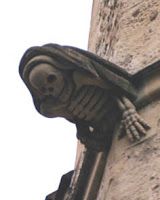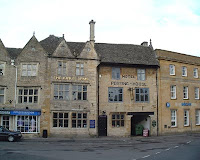Gargoyles!
 I was tidying up my study and came across this article on gargoyles and it was so interesting I thought I would share it. Aren't they pretty!
I was tidying up my study and came across this article on gargoyles and it was so interesting I thought I would share it. Aren't they pretty!The gargoyle originated as plumbing. They can be traced back to Ancient Greece, Egypt and Rome when decorated terracotta waterspouts depicting lions, eagles and other creatures were common. Today they are still visible on the Parthenon in Athens and at the ruins of Pompeii. The word "gargoyle" comes from the French gargouille (throat) from which the verb to gargle also derives.
The gargoyle was, however, a rather splashy way to dispose of rainwater and in 1241 King Henry III invented the drainpipe, instructing the Keeper of Works at the Tower of London "to cause all leaden gutters... to be carried down to the ground." Lead drainpipes began appearing in quantity in the Tudor period. At the top of these pipes where the gargoyle had originally sat, there was often an open-topped box known as a rainwater head. In the great houses this was often decorated with a coat of arms. It took until 1724 however for the drainpipe to catch on in cities. Prior to that a Londoner venturing out in a downpour would run the risk of a hundred water spouts cascading onto his head.
It was around 1220 that the gargoyle as decoration really leapt to fame,  clinging to the corners and roofs of buildings. Medieval carvers let their imaginations run riot and created fantastical figures, animals, humans, some half and half. Magdalen College Oxford has a collection of hippopotami, wrestlers, a jester, a griffin, a greyhound, a camel and several monsters.
clinging to the corners and roofs of buildings. Medieval carvers let their imaginations run riot and created fantastical figures, animals, humans, some half and half. Magdalen College Oxford has a collection of hippopotami, wrestlers, a jester, a griffin, a greyhound, a camel and several monsters.
 clinging to the corners and roofs of buildings. Medieval carvers let their imaginations run riot and created fantastical figures, animals, humans, some half and half. Magdalen College Oxford has a collection of hippopotami, wrestlers, a jester, a griffin, a greyhound, a camel and several monsters.
clinging to the corners and roofs of buildings. Medieval carvers let their imaginations run riot and created fantastical figures, animals, humans, some half and half. Magdalen College Oxford has a collection of hippopotami, wrestlers, a jester, a griffin, a greyhound, a camel and several monsters.  Some gargoyles were intended to ward off evil spirits. The gargoyles on Notre Dame in Paris are said to watch for drowning victims in the Seine and fly down at night to rescue them. I thought this picture was enough to inspire a paranormal romance! Some gargoyles display the physical characteristics of the devil including wings, fangs and clawed feet. A few gargoyles also represent real people, including those on the church at Winchcombe where the gargoyles include the Lord of the Manor.
Some gargoyles were intended to ward off evil spirits. The gargoyles on Notre Dame in Paris are said to watch for drowning victims in the Seine and fly down at night to rescue them. I thought this picture was enough to inspire a paranormal romance! Some gargoyles display the physical characteristics of the devil including wings, fangs and clawed feet. A few gargoyles also represent real people, including those on the church at Winchcombe where the gargoyles include the Lord of the Manor.
The Victorian age saw a revival in gargoyles with many churches and country houses from the era bedecked with them, including Knightshayes Court in Devon and Knebworth House in Hertfordshire. Gargoyles also found new homes on the churches and skyscrapers of New York, Washington and Chicago. Washington National Cathedral has 112 gargoyles including one of a hippie, one of a crooked politician and one of Darth Vader!
So which gargoyle is your favourite?






Comments